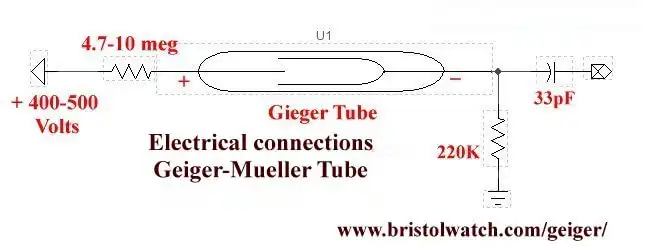Uranium Basics and Isotopes
by Lewis Loflin
Note: 1oz = 28.35 grams; 1lb = 16oz = 453.6 grams.
Molecular weight is based on Avogadro constant = 6.022 X 10^23; that's the number of atoms per mole and it has lots of zeros. The atomic weight of an element equals the atomic number, which is the number of protons (positive charges in the nucleus or atomic number) plus the number of neutrons (no charge particles) in the nucleus. Uranium is element 92 in the charts so has 92 protons, but the number neutrons can vary.
U238 has 92 protons and 146 neutrons. U235 has 92 protons and 143 neutrons. One mole of U238 ( 6.022 X 10^23 atoms) is 238 grams; one mole of U235 is 235 grams. The difference in molecular weight between a mole of U235 and U238 is 3 grams, the secret to enriching uranium.
The chemical properties (or chemistry) of an element depends on the number of electrons. For the purpose of chemistry (I'm simplifying this) we are concerned mostly with the outer or valance ring of an atom which can contain 1 to 8 electrons. (Electrons have a negative charge and are equal to the number of protons.)
An isotope of an element has the same atomic number or number of protons, but a different number of neutrons in the nucleus. Uranium has three naturally occurring isotopes: U234, U235, and U238. (U234 at 0.0055% or 55 parts per million is so rare it's ignored.) Only U235 can undergo nuclear fission and makes up 0.72% of natural uranium.
Let's return to Virginia uranium where 1 ton (2000 lbs) of ore can yield 1.2 lbs (544 grams) of uranium. Thus only 0.138 Oz or 3.92 grams of actual nuclear fuel U235 is produced. The rest ends up as mostly depleted uranium or left in the spent nuclear fuel rods. Producing 1 ton of uranium one must process (usually leaching with acids, etc.) a lot of rock.
Yellowcake is refined uranium ore that's 80-90% uranium.
If we really had to we could reprocess spent nuclear rods (somewhere around 80,000 to 100,000 tons are sitting at nuclear power plants), and use the U238 and depleted uranium (uranium with the U235 removed which thousands of tons are in storage) into plutonium which is just as useful for nuclear power as U235. We could also use thorium which like uranium is not a rare chemical element.
Because all uranium isotopes have identical chemical properties (determined by the atomic number and valance ring) there's no way to separate or concentrate fissionable U235 with a chemical process.
This is known as enriched uranium where the concentration of U235 is increased. Low-enriched uranium (LEU) "has a lower than 20% concentration of 235U. Commercial light water reactors (LWR), the most prevalent power reactors in the world, uranium is enriched to 3 to 5% U235." To even being close to being used in a nuclear bomb would require a 20% or better enrichment. So even if someone stole an entire fuel rod they still can't make a bomb.
That 3 gram per mole difference mentioned above allows through various complicated processes the increase of the level of U235. Even 20% U235 really won't work as a bomb either. The Little Boy bomb, dropped by the United States on Hiroshima in 1945, used 64 kilograms (141 lbs) of 80% enriched uranium.
- Why we should not fear nuclear power.
- Nuclear Graveyards Abound with Life
- What About Humans and Nuclear Radiation?
- Radiation Basics They Should Teach in High School
- Astable CD4047 High Voltage Power Supply
- Geiger Counter and Radioactivity
- Introduction to Geiger-Mueller Counters and Electronics
- CD4047 Monostable Multivibrator Circuit
- Getting Real About Radiation Myths and Hazards
- Uranium Hype-Facts and Virginia Uranium
- Uranium Basics and Isotopes
- Climate Change and Volcanoes
- Geiger Counter Adventures in Radioactivity Literature
- Using TL431A Li-Ion Battery Charger Tutorials
- TL431A Lithium-Ion Cell Charging Circuits
- Charging Multi-Cell Lithium-Ion Battery Packs
- TL431 Over-Voltage, Under-Voltage Detector Circuits
- TL431A Constant Current Source Working Circuits Demo
- Arduino Measures Current from Constant Current Source
- Constant Current Source Theory Testing
- Arduino Controlled Power Constant Current Source
- LM317 Adjustable Current Boost Power Supply
- Constant Current Circuits LM334, LM317
- Build LM317 0-34 Volt Power Supply
- LM334 Constant Current Source with Resistive Sensors
- LM317 High Power Constant Current Source Circuit
- LM317 Constant Current Source Circuits
- Test SCRs and Triacs
- Basic MOSFET Transistor Test Circuits
- High Voltage MOSFET Switching Circuits
- 3 Amp LM741 Op-Amp Constant Current Source
- Current Limiter Testing of Zener Diodes
- Current Limiter for Opto-Coupler Inputs
- LM317 CCS for Light Emitting Diodes
Web site Copyright Lewis Loflin, All rights reserved.
If using this material on another site, please provide a link back to my site.
